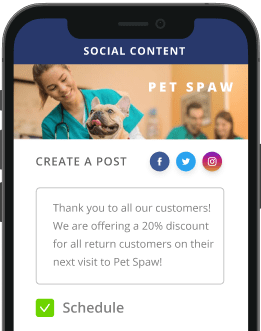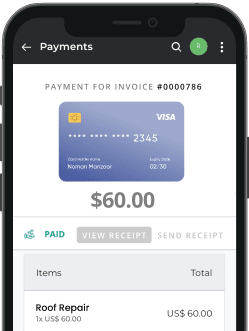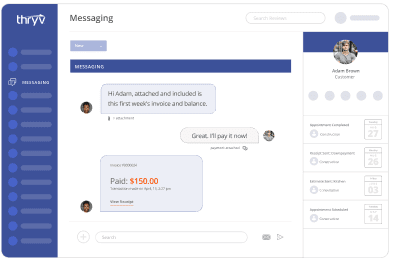12 HVAC Marketing Ideas to Improve Your Online Presence
Marketing your HVAC business is the key to keeping a steady pipeline of customers. But when you’re busy making service calls, generating estimates, and managing staff, it’s hard to find time to even think about your marketing plans, let alone put them to work.
Luckily, there are lots of ways you can connect with customers that take very little time or, with automation, no time at all. Whether you’re just starting an HVAC business or you’ve been in the game for years, the best marketing ideas for HVAC firms can help you show up online, connect with customers, and keep those service calls coming in.
Here are 12 proven HVAC marketing strategies to boost your online presence and grow your small business.
1. Make your Google Business Profile shine
Think of your Google Business Profile as your HVAC shop window on the web. It’s one of the easiest and most powerful ways to show up when someone searches “HVAC repair near me.” This free tool from Google helps your business appear in search results and on Google Maps with all the information customers need to reach you. That means your name, contact info, service area, hours, photos, and even reviews show up right where it matters most.
Here’s how to make the most of it:
- Keep your info up to date. Make sure your phone number, service hours, website link, and service area are accurate and consistent with the rest of your online listings and website. If your hours change seasonally, update them promptly.
- Add high-quality photos. Include pictures of your team, branded trucks, completed installations, and even behind-the-scenes shots. It builds trust and shows you’re the real deal.
- Post updates regularly. Just like a social media feed, you can share short updates, offers, or reminders right on your Google profile. These updates can boost engagement and keep your business top of mind.
- Respond to questions and reviews. Customers may leave questions directly on your profile. Answering them quickly shows you’re attentive and reliable. Likewise, thanking customers for positive reviews (and professionally addressing any negative ones) builds your reputation and encourages more feedback.
2. Build a website that earns trust
Your website isn’t just a digital business card – it’s the central hub of your HVAC marketing strategies. It’s often the first impression a customer gets of your business, and in today’s digital-first world, it’s one of the most important ways to build trust, answer questions, and drive new business.
Think of your website as your best salesperson. It works 24/7 and is always available. If built well, your site can educate prospects, convince them to reach out, and help them book an appointment on the spot. A professional, easy-to-navigate site signals you’re a legitimate, trustworthy operation. On the flip side, a cluttered or outdated website can send customers running to your competitors.
- Highlight services: Your site should highlight your key HVAC services, the areas you serve, and any specializations like duct cleaning, emergency repairs, or commercial work. Include clear calls to action like “Request a quote,” “Book now,” or “Call today.”
- Communicate value: Beyond listing services, your website should actively communicate your value. That means adding customer testimonials, photos of your work, and visual badges or text showing your HVAC technician certification & license. These signals build trust with visitors and help them feel confident choosing your team.
- Share your story: Use your website to share your story, too. Introduce your team, explain your values, and show your connection to the local community. This is especially powerful for small businesses trying to stand out in a competitive market.
- Make it mobile-friendly: Make sure your site works on mobile – more than half of web traffic comes from phones and tablets. A fast, responsive design provides a smooth user experience and is rewarded by search engines.
- Integrate it with other efforts: Connect it to your Google Business Profile, link it to your social media pages, and use it as the foundation for your email marketing and HVAC lead generation campaigns. Add features like live chat, online booking, payment portals, and automated quote requests. With the right tools and small business software for HVAC businesses, you can track site visitors, manage leads, and even automate follow-ups, turning your website into a true marketing engine.
3. Get listed in online directories
Online directories are one of the most underrated but powerful tools in your HVAC marketing toolbox. These platforms – like Yelp, Angi, Thumbtack, HomeAdvisor, and Bing Places – help potential customers discover your business when they search for HVAC services in their area. Think of them as modern-day phone books but with added benefits like reviews, photos, and direct contact options.
Here’s how to get the most impact from online directories:
- Make sure your business appears on Yelp, Angi, HomeAdvisor, Thumbtack, and Bing Places.
- Fill out every field in your profiles – business name, phone number, address, website link, services offered, service area, and high-quality images.
- Keep your info consistent across every platform. Inconsistent listings can hurt your search rankings and confuse potential customers.
- Encourage happy customers to leave reviews and respond to them promptly. Positive reviews build trust and influence purchasing decisions.
4. Manage local SEO with local service pages
Local SEO (search engine optimization) is all about helping your business show up first when someone types “HVAC repair near me” or “air conditioning installation in [Your City].” It may also help you land in Google’s coveted Map Pack: the top three local listings that show up next to a map at the top of search pages.
To improve your local SEO rankings:
- Create dedicated website pages for each city or neighborhood you serve.
- Use location-specific keywords and service terms to boost visibility.
- Add driving directions, neighborhood landmarks, or local partnerships to help search engines (and people) trust your business.
- Include your business name, address, and phone number (NAP) consistently on every page.
- Link these local service pages to your Google Business Profile and online directory listings.
5. Share content that sticks with people
Great content doesn’t just fill space – it builds relationships. When you share useful blog posts, how-to guides, or seasonal checklists, you stay on customers’ minds even when they’re not booking a service. So when the AC goes out or the furnace starts acting up, guess who they’ll call? You.
Helpful content also shows you know your stuff, which makes you more trustworthy in a competitive market. It also plays a big behind-the-scenes role: boosting SEO, feeding your social media, powering email campaigns, and keeping your website active.
A single post done right can keep bringing in traffic – and potential leads – for months.
Use your website and blog to answer common questions and show your expertise.
- Create how-to posts on seasonal maintenance, duct cleaning, or thermostat troubleshooting.
- Offer tips homeowners can use right away, then show how your team can help.
6. Get social to stay visible
Social media might not be where you close the sale, but it’s often where you start to build trust. It helps you connect with new prospects, stay on your current customers’ radar, and show the human side of your HVAC business.
Platforms like Facebook, Instagram, and YouTube let you spotlight your work, introduce your team, and share tips that prove you know your stuff. When people see consistent, friendly updates from your business, they’re more likely to remember and trust you when it’s time for service.
- Use Facebook and Instagram to share photos of your work, seasonal tips, and behind-the-scenes looks.
- Celebrate customer milestones, post seasonal maintenance reminders, or share tips on energy savings and air quality.
- Engage with your community – comment on local events, respond to messages quickly, or offer neighborhood-specific deals.
7. Run targeted digital ads
The beauty of digital advertising is that it puts you in front of customers at the exact moment they need help with their heating or cooling system. Whether it’s pay-per-click (PPC) ads on Google or social ads on Facebook and Instagram, digital ads are also incredibly cost-effective when done right. You can start with a small budget, test different messages, and scale up what’s working.
- Use Google Local Services Ads to reach local leads who need help fast. These appear at the very top of search results and include a Google Guarantee badge for added trust.
- Try Facebook ads to reach homeowners in specific ZIP codes, neighborhoods, or income brackets. You can promote seasonal offers or spotlight specialty services.
- Run ads that promote specific services or discounts. Great marketing strategies for HVAC are always timely and targeted, like promoting heating services before winter hits or AC maintenance in early spring.
8. Stay top of mind with smart emails
Email marketing is like the duct tape of your HVAC strategy – it’s flexible, affordable, and gets the job done. It keeps your name in front of customers between service calls and builds loyalty that brings them back (and gets them talking).
The best part? You’re not fighting for space in a social feed or crossing your fingers with an algorithm. Your message lands right in their inbox – where you can speak directly to them on your terms. It helps you keep your brand front and center between service calls. It also builds loyalty, leading to repeat business and referrals.
- Send seasonal checklists, energy-saving tips, and exclusive offers.
- Automate reminders for annual maintenance or filter changes.
- Personalize emails with automation to increase trust and even generate upsells on additional services.
9. Ask customers for reviews
People trust other people. That’s why great reviews are like gold for your HVAC business. They tell potential customers that you’re trustworthy and make it way more likely you’ll get the call over a competitor.
Most homeowners want a little reassurance before booking a service, and online reviews deliver that in spades. They also give your SEO a nice boost – Google loves a business with lots of high-quality feedback, especially from local customers.
To make reviews work for you:
- Ask for reviews after every job – text or email requests work best because they’re direct and easy to act on.
- Make it even easier by providing a direct link to your Google or Yelp page. The fewer steps involved, the more likely a customer will leave feedback.
- Respond to every review, even the negative ones. Thank happy customers and professionally address any unhappy comments. This shows you’re attentive and committed to customer satisfaction.
- Feature glowing reviews on your website, social media, and email campaigns. This kind of user-generated content reinforces your value and builds trust with future customers.
10. Let automation do the heavy lifting
Automated marketing software is like your digital assistant, quietly handling all the behind-the-scenes stuff while you focus on fixing systems and growing your business.
Automation helps you stay on top of everything without working around the clock. No more forgotten follow-ups or missed review requests. It keeps your brand present, your leads warm, and your workflow running smoothly – all without piling more on your plate.
Use automated software for HVAC companies to manage appointments, invoicing, and follow-ups from one dashboard.
- Automate repetitive tasks like sending review requests after service, scheduling social media posts, or delivering seasonal email campaigns.
- Send emails automatically, using triggers based on customer behavior. For example, you might send an email reminder for a maintenance visit 11 months after a previous service call.
- Tools like automated HVAC management software for online listings, monitoring reviews, and sending texts help you reduce manual errors, save time, and ensure nothing slips through the cracks.
11. Measure your results
Good HVAC marketing ideas are only great if they’re working. Tracking your results helps you understand what’s resonating with customers, where your time and money are best spent, and how to improve over time. Without data, you’re just guessing. Measuring results gives you the clarity and confidence to make smarter decisions and optimize your HVAC marketing strategies.
- Track where your leads come from – your website, ads, social, or referrals – so you can double down on what works.
- Monitor performance using built-in dashboards from your HVAC business software to identify trends and conversion rates.
- Use data to guide your next move. Tweak ad copy, test subject lines, refine local SEO, or change your posting schedule based on what’s getting clicks and calls.
- Set clear goals for each channel – whether it’s lead volume, click-through rates, or customer reviews – and review your metrics regularly to stay on track.
12. Do it all with Thryv®
Thryv is a business management software designed specifically for small businesses – including HVAC companies. It provides a complete suite of tools for HVAC businesses that help you manage your day-to-day operations, stay connected with customers, and grow your business more efficiently.
Thryv software for marketing for HVAC firms delivers everything you need to simplify and automate your efforts to reach customers. From managing your online listings and Google Business Profile to simplifying social media and automating email marketing, Thryv lets you market, sell, and grow your company from a single platform.
Here are just a few ways Thryv’s HVAC software for small businesses can benefit you.
- One login gives you access to everything: scheduling, communication, billing, marketing, and reputation management – even free HVAC calculator tools.
- It’s cloud-based HVAC software, so you can run your business from your truck, job site, or office – on any device.
- Automated marketing features let you stay in touch with leads and customers without lifting a finger.
- Built-in tools for collecting payments, sending estimates, and booking jobs make it easier for customers to do business with you.
- With review monitoring, lead tracking, and custom dashboards, you’ll have data to make smarter business decisions.


